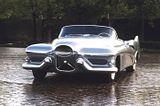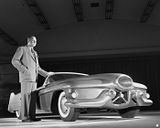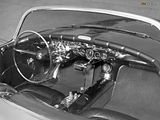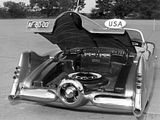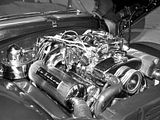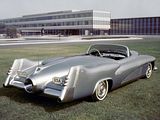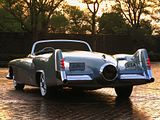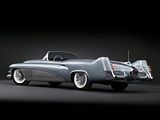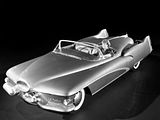Cars of Futures Past Ė 1951 GM Le Sabre ConceptHemmings Daily: Kurt Ernst Apr 25th, 2014 Legendary automotive designer Harley Earl had a compulsion to outdo his rivals. In 1938, his Buick Y-Job, often considered to be the first true concept car, set the tone for automotive design in the immediate prewar years. Following the conclusion of the Second World War, the Y-Job, now seven years old, began to feel dated to Earl; his response was the 1951 GM Le Sabre concept (detailed in SIA #158), a car that innovated everything from style through construction through the implementation of technology in the automobile. From the beginning, the Le Sabre was conceived as Harley Earlís personal automobile, and Earl held a (generally accurate) belief that if he liked something, the American public would also like it. Influenced by the dawn of the jet age, and more specifically by the North American Aviation F-86 Sabre fighter, Earl envisioned a car that would blend aircraft styling and functionality with more traditional automotive design. In other words, it wasnít enough for the concept to look like a jet; because Earl had every intention of using the Le Sabre as his personal automobile, it had to function well as an automobile, too. Befitting the designerís flamboyant nature, it also needed to be equipped with the latest gadgetry, perhaps prompting other designers to ponder why they hadnít thought of the idea first. Earl had appointed Edward E. Glowacke to oversee the Special Automobile Design studio, which gave him (some) oversight on the creation of the Le Sabre. Glowacke can be directly attributed with some of the carís styling elements, such as the pointed bumper ďbullets,Ē the jet-intake-like oval grille, and the carís aircraft-like cockpit. GM engineer Charlie Chayne was tasked with creating the carís V-8 engine and drivetrain, and for such an exceptional concept car, no ordinary engine would do. Not only would it need to be powerful enough to satisfy Earlís expectations, but it would also need to be compact (and short) enough to fit with the designerís long and low motif. Chayneís choice was a newly designed cast-aluminum 215-cu.in. V-8, which was also fitted to the Le Sabreís sister car, the Buick XP-300. For duty beneath the Le Sabreís front fenders, the engine received a rather unique dual-carburetor setup; one would feed gasoline, supplying power for steady-state cruising, while the second would add methanol to the mix to enhance output during hard acceleration. To further increase the power, the engine (which utilized cast-aluminum hemispherical cylinder heads) also incorporated a Roots-type supercharger pushing 18.2 PSI of boost, and the result was an impressive 335 horsepower and 381 pound-feet of torque. Underneath, the car was just as advanced. For reasons of packaging, Chayne moved the transmission (originally a Buick Dynaflow, but later a GM Hydra-Matic) to the rear of the car, also improving weight distribution. The De Dion rear was suspended via a transverse leaf spring and shock absorber arrangement, but the front suspension used a rather unconventional setup. Instead of coil springs and dampers or even torsion bars, the Le Sabre used a pivot rod embedded in a solid rubber cylinder, encased in steel. The rubber acted as a spring, and the motion was controlled with the use of conventional shock absorbers. The setup worked reasonably well, until the rubber inside the cylinder began to dry and crack; at that point Chayne substituted a more conventional torsion bar front suspension in the Le Sabre. As innovative as the unseen parts of the car were, it was the Le Sabreís exterior styling that captivated auto show audiences. Up front, the carís most prominent features were the wraparound windshield (the first on a GM automobile) and the aircraft fuselage-inspired snout, capped with a large oval grill. No headlamps were visible in this design, but at the flip of a switch, the grille swiveled to reveal them. At the rear of the Le Sabre, dual tail fins rose high above the decklid, and the jet aircraft theme was prominently displayed with an oversize central taillamp, meant to evoke the image of a lit afterburner. The tail fins were more than a design touch; also borrowing from aircraft design, each one held a rubberized fuel bladder, one to store gasoline and the second to hold methanol. Even the body itself broke new ground, as it used cast magnesium body panels in conjunction with an aluminum honeycomb floor and steel panels (riding on a boxed steel frame). The entire cowl was crafted from cast magnesium, as was the hood and the decklid; given the expanses of the panels, ribs were cast into both to add strength and rigidity. Doors and front fender valences were also made of cast magnesium, and in some areas the material is up to a quarter-inch thick. Befitting a car this ambitious, the convertible top was power operated, relying on electric motors to raise or lower it. The console between the seats also contained a moisture sensor, and when rain was detected, the top automatically lifted itself into position, followed by the windows. Itís said that the Le Sabre never failed to attract a crowd when the weather turned nasty, and onlookers marveled at this bit of futuristic technology. Had a tire gone flat on the Le Sabre, itís likely that spectators would have been equally impressed with the carís four hydraulic jacks, which allowed the driver to raise any corner of the car to facilitate tire changing. Any resemblance between the Le Sabreís cockpit and that of a jet aircraft was purely intentional, as the concept was meant to be as cutting-edge as a fighter jet. The driverís seat was power adjustable, and both driver and passenger enjoyed heated seats. Below the dashboard, the cruise control knob allowed the driver to select the desired speed via a rotating dial. A conventional speedometer wouldnít do, so a digital gauge was chosen, and to allow for various lighting conditions, its brightness could be adjusted via a rheostat. Though the Le Sabre wasnít actually designed to fly, Glowacke even thought to include both a compass and an altimeter in the dashboard, one more nod to the carís aircraft influence. The Le Sabre never saw production, but it did foreshadow numerous automotive design trends to come. Tailfins would soon become all the rage in Detroit, while the low beltline and hidden convertible top would appear on the semi-custom 1953 Oldsmobile 98 Fiesta convertible, the 1953 Cadillac Eldorado convertible and the 1953 Buick Skylark convertible. Depending upon the source, Earl either drove the car for several years after its show circuit tour, or all the way up to his 1958 retirement, putting an estimated 45,000 miles on the concept. Today it remains in the GM Heritage Center collection. |



